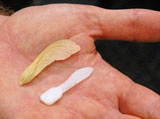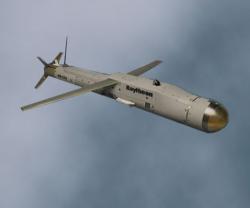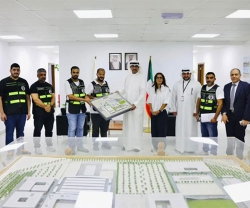LM Unveils Samarai Flyer at AUVSI
19.08.2011 North America
Inspired by a maple seed, Lockheed Martin's Samarai handheld vehicle flew publically for the first time at the Association for Unmanned Vehicle Systems International (AUVSI) conference currently taking place at the Walter E. Washington Center in the US (16-19 August 2011).
Weighing less than half a pound, Samarai demonstrated vertical takeoff and landing, stable hover, and on-board video streaming. While the aircraft flew a series of flights in the roughly 40 foot test area, it streamed live video from a camera that rotated around its center providing a 360 degree view without a gimbal.
"Our team has taken the basic shape and design of the naturally aerodynamic maple seed and harnessed it with flight controls and avionics," said Kingsley Fregene, Principal Investigator for Samarai at Lockheed Martin's Advanced Technology Laboratories.
"We've learned a great deal about biologically inspired vehicles that we can apply across the laboratory, including a better understanding of micro-robots and the devices that control their movement", he continued.
Samarai is mechanically simple with only two moving parts. Because its 16 inches long and weighs less than half a pound, an operator can easily carry the vehicle in a backpack and launch it from the ground or like a boomerang. The design is scalable to meet different missions, including surveillance and reconnaissance and payload delivery.
Lockheed Martin tested the first 3-D printed Samarai last week. The vehicle was produced by "printing" successive small layers of plastic to create a single form. The printer eliminates expensive production costs, allowing engineers to quickly and affordably produce Samarai tailored to specific missions.
Weighing less than half a pound, Samarai demonstrated vertical takeoff and landing, stable hover, and on-board video streaming. While the aircraft flew a series of flights in the roughly 40 foot test area, it streamed live video from a camera that rotated around its center providing a 360 degree view without a gimbal.
"Our team has taken the basic shape and design of the naturally aerodynamic maple seed and harnessed it with flight controls and avionics," said Kingsley Fregene, Principal Investigator for Samarai at Lockheed Martin's Advanced Technology Laboratories.
"We've learned a great deal about biologically inspired vehicles that we can apply across the laboratory, including a better understanding of micro-robots and the devices that control their movement", he continued.
Samarai is mechanically simple with only two moving parts. Because its 16 inches long and weighs less than half a pound, an operator can easily carry the vehicle in a backpack and launch it from the ground or like a boomerang. The design is scalable to meet different missions, including surveillance and reconnaissance and payload delivery.
Lockheed Martin tested the first 3-D printed Samarai last week. The vehicle was produced by "printing" successive small layers of plastic to create a single form. The printer eliminates expensive production costs, allowing engineers to quickly and affordably produce Samarai tailored to specific missions.
Previous PostLockheed Martin-Kaman Aerospace Win US Army Contract
Latest news
Latest events
DefenPol China2025 - 7th Guangzhou International Defense & Police Exhibition & Summit
11 - 12 Jul 2025Nan Fung International Convention & Exhibition Center (NICEC) - ChinaIDEF 2025 Turkey - International Defence Industry Fair
22 - 27 Jul 2025Istanbul Expo Center - TurkeyDSEI 2025
09 - 12 Sep 2025Excel, London - United KingdomIntersec Saudi Arabia
29 Sep - 01 Oct 2025Riyadh International Exhibition & Convention Centre - Saudi Arabia






















